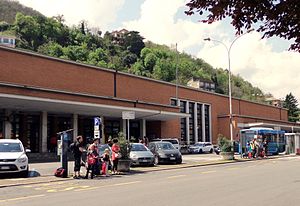Como San Giovanni railway station
|
Como San Giovanni
|
|||||||||||
|---|---|---|---|---|---|---|---|---|---|---|---|
 |
|||||||||||
| Location |
Como, piazzale San Gottardo |
||||||||||
| Coordinates | Template:IT-CO_type:railwaystation 45°48′33″N 09°04′22″E / 45.80917°N 9.07278°E | ||||||||||
| Operated by | RFI | ||||||||||
| Line(s) |
Milan–Chiasso Como–Lecco |
||||||||||
| Tracks | 3 | ||||||||||
| Construction | |||||||||||
| Structure type | at-grade | ||||||||||
| History | |||||||||||
| Opened | July 27, 1875 | ||||||||||
| Rebuilt | 1949 | ||||||||||
| Electrified | 1939 | ||||||||||
| Services | |||||||||||
|
|||||||||||
Como San Giovanni railway station (Italian: Stazione di Como San Giovanni) is the main station serving the city and comune of Como, in the region of Lombardy, northern Italy. Opened in 1875, it forms part of the Milan–Chiasso railway, and is also a terminus of the Como–Lecco railway, which branches off the main line a few kilometres (miles) to the south, at Albate-Camerlata.
Como San Giovanni is the last Italian station on the line to Chiasso, and therefore fulfils the functions of a border station. However, customs checks have not been carried out there since 2008, when Switzerland joined the Schengen Agreement.
The station is currently managed by Rete Ferroviaria Italiana (RFI), but the commercial area of the passenger building is managed by Centostazioni. Train services are operated by Trenitalia. Each of these companies is a subsidiary of Ferrovie dello Stato (FS), Italy's state-owned rail company.
Como San Giovanni railway station is situated in Piazzale San Gottardo, a short distance to the west of the city centre.
The station was opened on 27 July 1875, upon the inauguration of the Albate–Como section of the Milan–Chiasso railway.
The current passenger building was built after the destruction of World War II, to a design of Paolo Perilli. It was inaugurated in 1949. A structure in brick on two levels (of which only the ground floor is accessible to travellers), it consists of three sections joined together by a glass wall that provides much of the lighting inside the central hall. It is also attached to shelters facing the station yard.
...
Wikipedia
